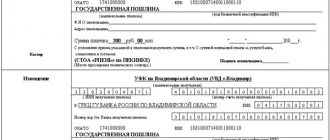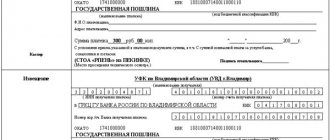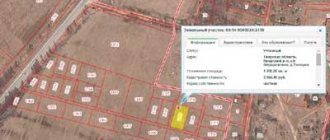in the context of price-forming factors that have a significant impact on the market value of real estate objects of the corresponding group (subgroup). The list of factors that have a significant impact on the market value is compiled on the basis of the expert opinion of the appraiser, taking into account the results of the analysis of the real estate market. The description of a typical object includes both factors included in the valuation model that have a significant impact on the market value, and factors not included in the valuation model;
indicating the ranges of values of pricing factors accepted by analogue objects of the corresponding group (subgroup);
indicating the average level of cadastral value, calculated on the basis of the corresponding model, for assessment zones.
5.4. Cost calculation by model
The constructed statistical model must express the dependence of the cadastral value or the specific indicator of cadastral value on the values of cost factors.
If the constructed statistical model expresses the dependence of the cadastral value on the values of cost factors, then the cadastral value is calculated by substituting the values of cost factors into the statistical model for calculating the cadastral value.
If the constructed statistical model expresses the dependence of the specific indicator of cadastral value on the values of cost factors, the cadastral value is determined as follows:
the specific indicator of the cadastral value is determined by substituting the values of the cost factors of the valuation object into the statistical model for calculating the specific indicator of the cadastral value;
The cadastral value of the valuation object is determined by multiplying the specific indicator of the cadastral value by the area of the valuation object.
Report requirement: the report must indicate the model and description of the procedure for calculating the cadastral value.
What additional functions have cadastral chambers acquired?
According to the new law, Rosreestr will be vested with control and supervisory functions in relation to the state cadastral valuation.
The heads of state budgetary institutions that establish the cadastral value will have personal responsibility for its determination. If it is discovered that the cadastral value is overestimated, officials will be threatened with dismissal.
The Cadastral Chamber will provide information about real estate for cadastral valuation, and also recalculate the cadastral value if necessary (based on the results of calculating the real estate market index).
Public cadastral map of Russia.
Source: Fixie LLC
According to the previous version of the law, the authority to calculate the real estate market index belonged to Rosreestr.
5.5.Method of a typical (reference) object (reduces to individual calculation)
5.5.1. Determination of the cost of a reference or standard object with subsequent adjustment of each valuation object, taking into account the difference in price-forming characteristics from the reference (base) object.
The type object method is as follows:
- a group of assessment objects is determined in which it is possible/advisable to type assessment objects;
- the basis for typification is determined - a characteristic or group of characteristics of the objects of assessment, on the basis of which it is possible to group the objects of assessment by type;
- typification of assessment objects is carried out;
- a standard assessment object is formed
- the cost of a typical valuation object is determined
-depending on the type of permitted use of the valuation objects, adjustments may be made to the value of the objects when the cost of a typical valuation object is distributed to the valuation objects.
The object of assessment can be either directly the objects of assessment or a standard object of assessment. Analogue objects can also be either directly analogue objects or a standard analogue object.
5.5.2. Determining the cost of a reference or base object with subsequent equating the unit cost of other objects of this group (subgroup) to the unit cost of the reference or base object.
Cadastral valuation
Federal Law No. 237-FZ dated July 3, 2016 “On State Cadastral Valuation” (hereinafter referred to as Law No. 237-FZ), which entered into force on January 1, 2020, established a new procedure for conducting state cadastral valuation.
One of the main innovations of the law is that the state cadastral valuation is carried out by a state budgetary institution empowered to determine the cadastral value, created by a constituent entity of the Russian Federation.
State cadastral valuation is carried out no more than once every three years and at least once every five years.
At the same time, the possibility of conducting an extraordinary state cadastral valuation has been introduced, which is carried out in the event of a decrease in the real estate market index in a constituent entity of the Russian Federation by 30% or more since the date of the last state cadastral valuation.
The result of the state cadastral valuation is a certain cadastral value.
The state cadastral assessment is carried out in two stages.
Before January 1 of the year in which the cadastral value is determined, preparations are made for the state cadastral valuation, within the framework of which the budgetary institution collects and processes the information necessary to determine the cadastral value, including information about real estate objects whose cadastral value has been disputed.
During this period, copyright holders of real estate objects have the right to submit to the institution a declaration on the characteristics of the real estate object, information from which will be taken into account by the institution when determining the cadastral value.
In preparation for the state cadastral valuation, a budgetary institution sends requests for missing information about real estate necessary to determine the cadastral value to federal executive authorities, executive authorities of a constituent entity of the Russian Federation and local governments, as well as to organizations subordinate to them.
After making a decision to conduct a state cadastral valuation, the rights registration authority, at the request of the authorized body, provides a list of real estate objects subject to state cadastral valuation, compiled as of January 1 of the year the cadastral value was determined.
The budgetary institution, in accordance with the methodological instructions on the state cadastral valuation, processes the list. In this case, the type of use of the property is determined on the basis of written confirmation from local governments.
The results of processing the list are posted on the official website of the authorized body.
Further "
The general procedure for conducting state cadastral valuation is as follows.
Within the time limits established by the Law, the budgetary institution determines the cadastral value of real estate objects. Based on the results of determining the cadastral value, the budgetary institution draws up and posts a draft report on its website, and also sends it to the rights registration authority for verification of compliance with established requirements and for placement in the State Cadastral Valuation Data Fund (on the Rosreestr website).
Any interested person can submit his comments on the interim reporting documents within 50 days from the date of posting the interim report in the State Cadastral Valuation Data Fund. Comments can be submitted to a budget institution or MFC in person, sent by mail or via the Internet.
Comments on interim reporting documents must comply with the requirements established by the Law on Cadastral Valuation. The comment may be accompanied by documents confirming the presence of errors made in determining the cadastral value, as well as a declaration on the characteristics of the property.
Based on the results of consideration of comments, the cadastral value may be recalculated. A recount can be made even if the owner did not submit his comments, but they were submitted by other persons in relation to other real estate objects, if the budgetary institution considers such a recalculation necessary.
At the same time, the budgetary institution is obliged to post updated interim data on its website every five days, as well as information about comments received that were not taken into account and the refusal to take them into account.
Further "
After the deadline for submitting comments on the draft report, the budgetary institution draws up a report.
The authorized body of the constituent entity of the Russian Federation approves the report by adopting an act approving the results of determining the cadastral value.
The law provides for the possibility of pre-trial challenging the cadastral value.
Any interested person can contact a budgetary institution for clarification on how the assessment was carried out and on correcting errors made in determining the cadastral value.
It should be noted that the budgetary institution is authorized to provide explanations only regarding the cadastral value of real estate, which it assessed.
If, during the consideration of such an appeal, errors are discovered in determining the cadastral value, the institution will be obliged to eliminate them at its own expense.
It should be noted that changes in the cadastral value obtained after correcting such errors are allowed only downwards.
Further "
The results of determining the cadastral value can be challenged by legal entities and individuals, if they affect the rights or obligations of these persons, as well as by state authorities and local governments in relation to real estate objects that are in state or municipal ownership, in a commission or in court.
To go to court, a preliminary application to the commission is not mandatory.
The commission is created on the territory of a constituent entity of the Russian Federation by an authorized body.
The composition of the commission has been clarified; now, in addition to one representative of the rights registration body, the commission includes one representative each from the authorized body, the authorized body for the protection of the rights of entrepreneurs and the commissioner for human rights in a constituent entity of the Russian Federation, the council of municipalities, the business community and self-regulatory organizations of appraisers.
By Decree of the Government of the Altai Territory dated June 22, 2017 No. 226, a decision was made to create the KGBU “Altai Center for Real Estate and State Cadastral Valuation” and determined the executive body authorized to carry out state cadastral valuation in the territory of the Altai Territory - the Department of Property Relations of the Altai Territory.
By order of the Department of Property Relations of the Altai Territory dated November 26, 2018 No. 1412, a decision was made to carry out a state cadastral valuation on the territory of the Altai Territory in 2020 in relation to: land plots of the category of agricultural land; land plots of the category of industrial lands and lands for other special purposes; capital construction projects (buildings, structures, premises, parking spaces, unfinished construction projects, unified real estate complexes, enterprises as property complexes and other real estate objects).
Further "
Information about the state cadastral valuation, regarding the timing and procedure for submitting declarations on the characteristics of real estate objects, comments on interim reporting documents, as well as about the approval of the results of determining the cadastral value will be carried out in the manner prescribed by the Law on Cadastral Valuation, on the websites of local governments , Department of Property Relations of the Altai Territory https://www.altairegion-im.ru and KGBU "ATsNGKO" https://www.altkadastr.ru, in the media, on information boards of management and local governments.
Particular attention should be paid to the fact that from January 1, 2020, in the Altai Territory, property tax for individuals will be calculated based on the cadastral value of taxable objects.
In order to reduce the tax burden, a special transitional procedure is in place for calculating property tax for individuals based on the cadastral value. Thus, for the first three tax periods from the beginning of application of the procedure, the tax base is determined based on the cadastral value of the taxable object, taking into account reduction factors of 0.2, 0.4 and 0.6, respectively.
In addition, tax deductions are provided that apply to all residential properties, regardless of the number of owners of this property.
The full cadastral value of a residential property is reduced by the cost of a certain number of square meters, depending on the type of residential property:
- for a residential building - 50 sq. m. m;
- for an apartment, part of a residential building - 20 sq. m. m;
- per room, part of the apartment - 10 sq. m.
Local authorities have the right to increase the amount of tax deductions.
If, when applying tax deductions, the tax base takes a negative value, for calculating the tax, this base is taken equal to zero and there is no need to pay tax.
Further "
More detailed information can be obtained from the link https://www.altairegion-im.ru/kadastr_new/
5.7.Method of indexing past results
This method allows determining the cadastral value of a group of objects by indexing the value of the cadastral value obtained as a result of the previous cadastral valuation. The appraiser does not have the right to independently apply this method without obtaining the customer’s approval. To apply this method, the appraiser initiates a meeting with the cadastral valuation customer, presents a justification for the impossibility of calculating any of the groups of objects using the methods described above, the inappropriateness of valuing objects of the presented group using individual valuation methods, as well as the approximate value of the multiplier coefficient taking into account price changes. The customer’s decision approves the assessment of the groups under consideration by the method of indexing previous cadastral valuation results with a mandatory indication of which cadastral valuation data should be subject to indexation.
Method for indexing the results of assessment of neighboring constituent entities of the Russian Federation. This method provides for the possibility of using the results of cadastral assessment of the constituent entities of the Russian Federation neighboring the subject being assessed. The procedure for applying indexation of data from neighboring entities is similar to the procedure for indexing past periods. The difference lies in the fact that at the IEC, in addition to justifying the impossibility or inappropriateness of using other methods, data is presented on the known characteristics of the groups in question in neighboring regions, possible deviations from the assessment results, taking into account regional differences and a different assessment date.
How will errors be corrected?
As mentioned above, the cadastral value of real estate is not a constant value and may change. If an error was made during its calculation, then it can (and should) be corrected.
Previously, in order to challenge such a value of real estate, owners had to go to court or a commission to resolve disputes about the results of determining the cadastral value.
But since August 11, the law has sided with the owners. It is aimed at protecting the interests of property rights holders.
Cadastral valuation of real estate.
Pixabay.com.
If, when an error is corrected, the cadastral value decreases, then it is changed to a reduced value for the entire period from the date the initial figure is entered into the state real estate register.
If the cadastral value increases, it will begin to apply only from the year following the year of its correction.
Is the physical deterioration of a building taken into account when determining the cadastral value of an object?
Physical depreciation for the state cadastral valuation is a loss of usefulness of a real estate property or its components associated with a temporary factor (natural aging) or operating conditions, which leads to a loss of value.
Physical wear and tear is calculated based on technical documentation data. When using technical documentation data, the date of completion of this documentation should be taken into account. When using retrospective data (the date of completion of which is more than 1 year from the date of determination of the cadastral value), it is necessary to introduce an adjustment for condition. If there is a sufficient amount of data on the physical deterioration of objects, it is recommended to build a model of wear accumulation by objects of one group (subgroup) broken down by similar objects in similar operating conditions (developed centers of a constituent entity of the Russian Federation, depressed territories).
To achieve the goals of determining the cadastral value, it is allowed to use different models of physical depreciation for different groups (subgroups) of real estate objects. It should be taken into account that the maximum calculated value of physical wear and tear cannot exceed the maximum wear and tear values during the operation of real estate objects, except in cases confirming the need for their demolition, the fact of their emergency and (or) dilapidated condition.
When calculating physical depreciation, the assumption is made that if the chronological age of a real estate object is 60 percent or more of its standard service life, it is assumed that the object was maintained in working order through periodic repairs, in which the object was not restored to a new condition, but was eliminated only visible defects and existing shortcomings that can affect performance characteristics. Moreover, if the chronological age is from 60 to 100 percent of its standard service life, the amount of accumulated wear and tear is taken equal to 60 percent, and if the chronological age exceeds the standard service life of the property, then the amount of accumulated wear is taken to be 70 percent.








